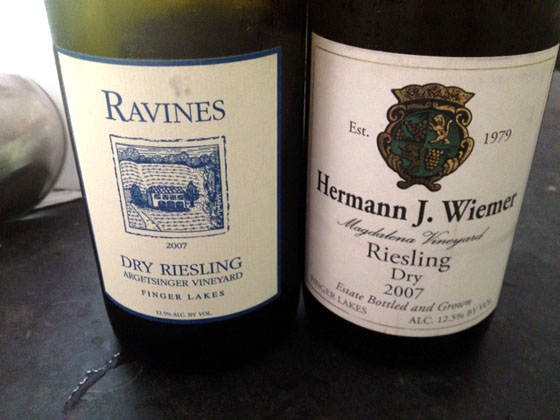What’s the worst riesling vintage of the past decade in the Finger Lakes? It’s an awkward question, given that winemakers in the Finger Lakes love to say that riesling performs beautifully in the regoin no matter the weather. That’s largely true, but it’s also a copout.
I’m willing to say that 2007 is the worst riesling vintage of the decade. It was a year of heat and drought, and the result was a region dotted by stressed vines. For red wines, it was generally a success. But for riesling, the balance between ripe fruit and crackling acidity was much more difficult to achieve. Many, many 2007 rieslings showed early signs of petrol — not necessarily undesirable, but as detailed by my colleague Tom Mansell, a warning sign that the wines will age more quickly than usual. (This entire short piece will do more to educate you on riesling in five minutes than most of what you can read in long books.)
In short, heat produces the components in grapes that eventually gives that petrol note, and more heat during harvest breaks that component down, leading to some premature, er, maturity.
So if you have 2007 Finger Lakes rieslings kicking around, it’s better to crack them sooner than later. That’s not to say the wines are shot; it’s just that they’re a product of a vintage that pushed wines off balance at an early age.
But here is where wine can be so much fun.
Sometimes a wine with big scores or a lofty reputation will fail to live up to the hype. In this case, we were staring at the labels of two of the most heralded wines of the Finger Lakes. And I was reminded that while it’s occasionally helpful to speak generally about wine, we must always be open to exceptions.
Last weekend a friend poured two wines blind for us. They were very clearly both rieslings, both Finger Lakes, both very high quality. Neither showed a whiff of petrol; both were layered and delicious. So we were surprised to see the vintage on both — 2007.
One was the Ravines Wine Cellars Argetsinger Vineyard, the other, Hermann J. Wiemer Magdalena Vineyard.
The Argetsinger was striking. This is a sharply dry wine that can be tear-inducingly mouth-watering shortly after release. But now we’re seeing what a little bottle age will do. The natural acidity ripples, but with a just-barely softer edge, allowing the complex nuances of the wine to stretch out and open up. No petrol, and a long, prosperous life awaits this wine.
The Magdalena is such a pure wine, so consistently fleshy and showy with its range of rich fruit. There was a distant echo of creaminess on the back end, which suggests a little more advancement. If I had any of this wine left — I don’t — I’d drink it soon, but wouldn’t be in a hurry to finish it off tomorrow.
If you’re wondering whether 2010 is in the same category as 2007 when it comes to Finger Lakes riesling, the answer is no. 2010 was long, warm, even, and occasionally wet. So the extended growing season produced strong red wines, but didn’t threaten riesling in the same way that 2007 did.
There is nothing wrong with a drink-now vintage. The best Finger Lakes rieslings typically offer a range of years to enjoy, but not many came through 2007 with much beyond a “drink-now” window. Turns out that the best sites, the best fruit, the most savvy winemakers can do surprising things — even when the most challenging vintage attempts to stand in their way.

